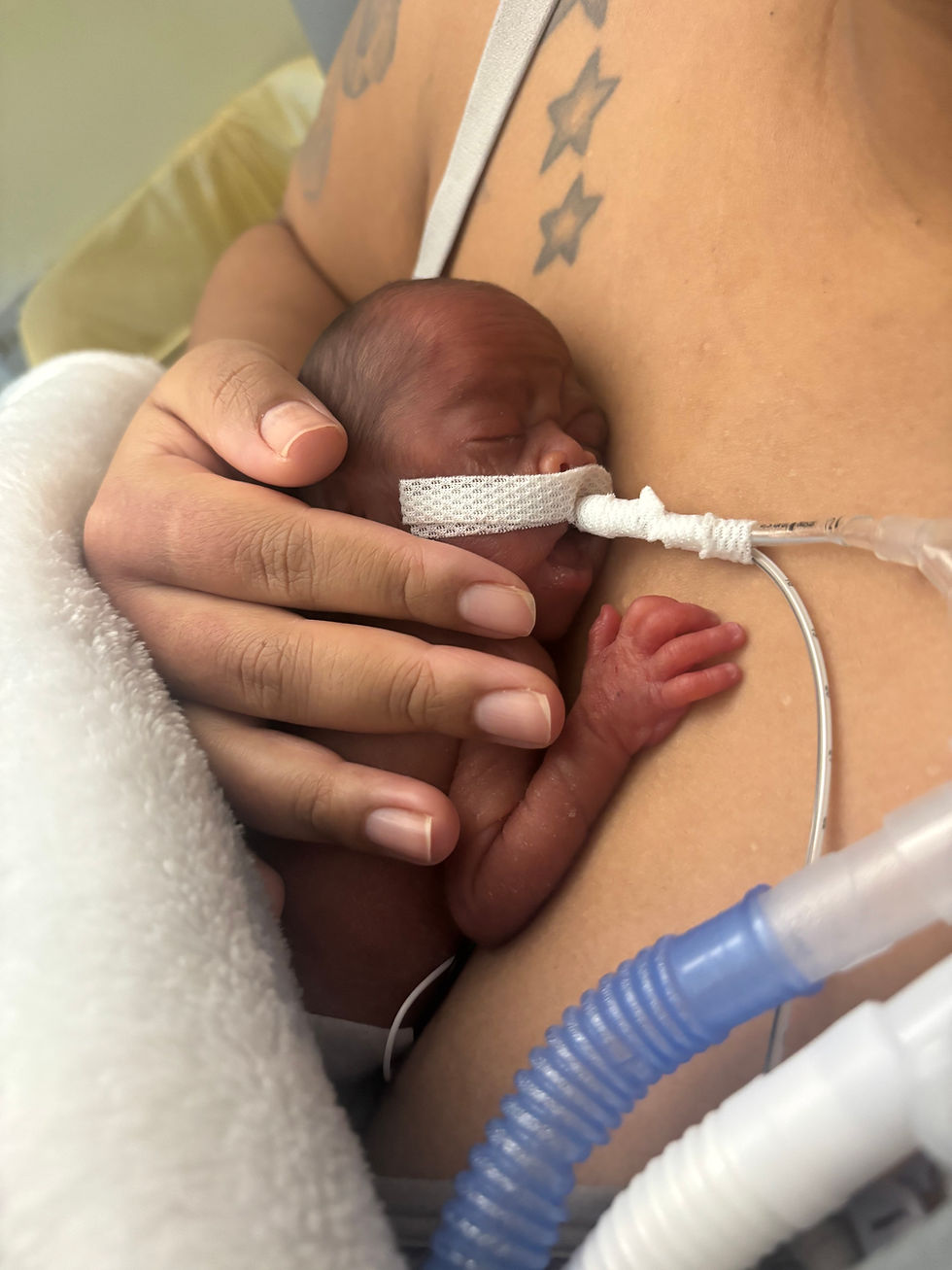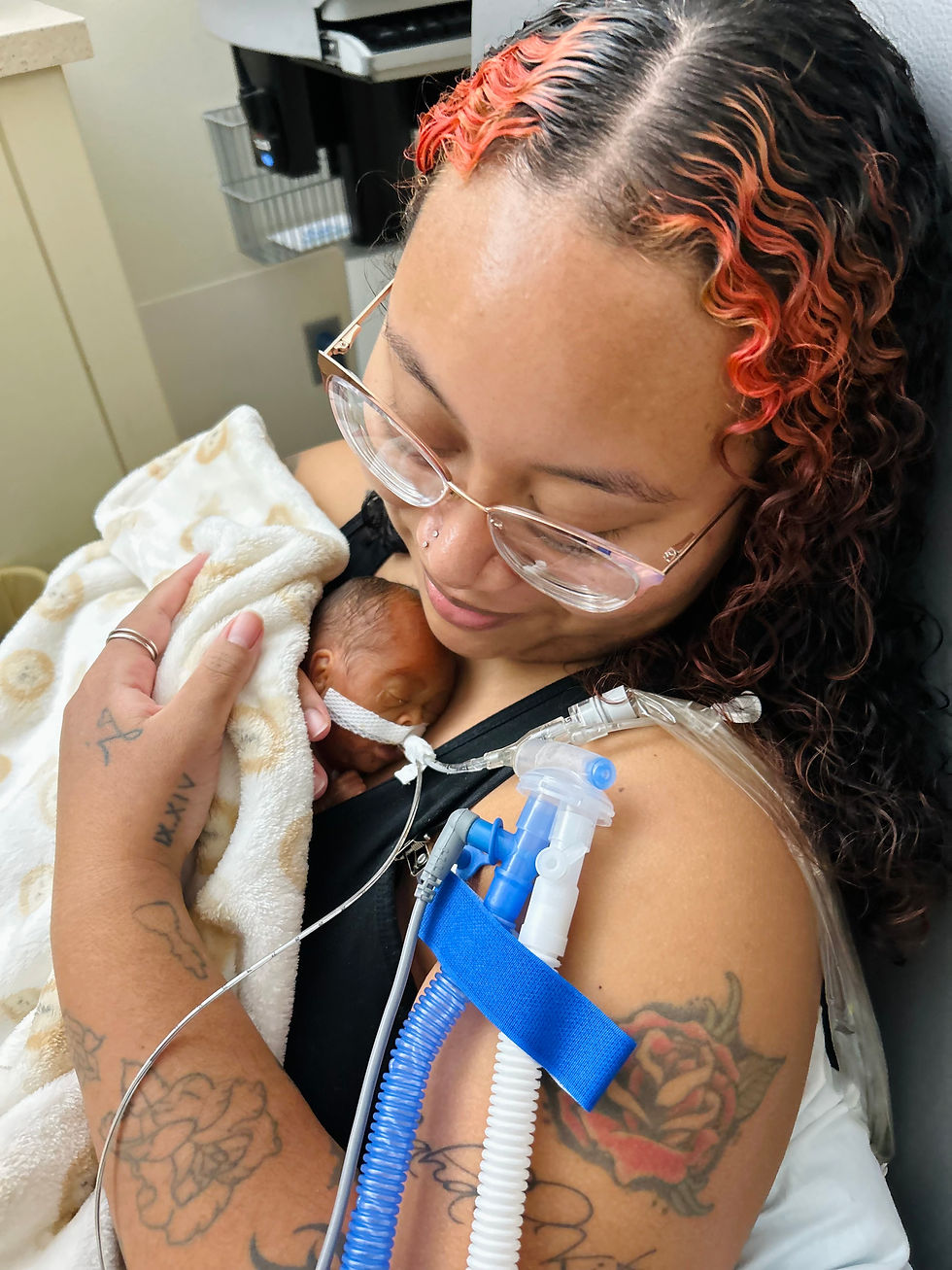Glossary Terms Commonly-Used in Neonatal Intensive Care

A family's journey through the Neonatal Intensive Care Unit is wrought with questions and concerns. You will hear many new terms and nicknames (would change to abbreviations) for items you may have never seen or even heard about before. Today Is A Good Day has taken the time to put together a Master Glossary Of Terms In The NICU (in the shouldn't be capitalized) for those looking to educate themselves or loved ones in the future
A prenatal test where a small amount of amniotic fluid is taken from the sac surrounding the fetus to test for genetic conditions or infections.
Amniocentesis
A condition where the baby has fewer red blood cells than normal, leading to reduced oxygen transport in the body.
Anemia
A quick test performed on a newborn at 1 and 5 minutes after birth to assess their physical condition and determine any immediate need for extra medical or emergency care.
Apgar Score
A temporary pause in breathing that can be common in premature infants.
Apnea
A special light blanket used to treat jaundice in newborns.
Biliblanket
A yellow pigment produced by the breakdown of red blood cells, high levels can cause jaundice.
Bilirubin
A test that measures the levels of oxygen, carbon dioxide, and pH in the blood, helping to assess respiratory function.
Blood Gas Test
A slower than normal heart rate, often associated with apnea in premature infants.
Bradycardia
A chronic lung condition that affects premature infants who have been treated with oxygen or ventilators.
Bronchopulmonary Dysplasia (BPD)
A treatment that uses mild air pressure to keep the airways open, often used in premature babies with breathing difficulties.
CPAP (Continuous Positive Airway Pressure)
A catheter placed into a large vein to administer medications or nutrition.
Central Line
A group of disorders affecting movement and muscle tone, often caused by damage to the developing brain either before, during, or shortly after birth.
Cerebral Palsy
The first form of milk produced by the mammary glands immediately following delivery, rich in antibodies.
Colostrum
Medications given to mothers at risk of preterm delivery to help accelerate the baby’s lung development.
Corticosteroids
A bluish discoloration of the skin due to low oxygen levels in the blood.
Cyanosis
An ultrasound test that creates images of the heart, often used to check for heart defects or monitor heart function in newborns.
Echocardiogram
A tube inserted through the baby’s mouth or nose into the trachea (windpipe) to help with breathing.
Endotracheal Tube (ET Tube)
A hormone used to treat anemia by stimulating red blood cell production.
Erythropoietin (EPO)
A treatment that uses a machine to pump and oxygenate a patient’s blood outside the body, allowing the heart and lungs to rest.
Extracorporeal Membrane Oxygenation (ECMO)
A condition resulting from alcohol exposure during pregnancy, causing developmental issues.
Fetal Alcohol Syndrome (FAS)
A condition where stomach contents flow back into the esophagus, common in premature infants.
Gastroesophageal Reflux (GER)
Feeding a baby through a tube that goes through the nose or mouth into the stomach, often used for babies who can't yet suck or swallow effectively.
Gavage Feeding
The age of the baby calculated from the mother’s last menstrual period, expressed in weeks.
Gestational Age
A sound made by infants who are having difficulty breathing, often an indication of respiratory distress.
Grunting
A blood test that measures the proportion of red blood cells in the blood.
Hematocrit
Another term for respiratory distress syndrome (RDS), a lung condition that is common in premature babies.
Hyaline Membrane Disease (HMD)
An abnormally high level of bilirubin in the blood, leading to jaundice.
Hyperbilirubinemia
Low blood sugar, which can be dangerous for newborns, especially those who are premature or have other health issues.
Hypoglycemia
A condition where the body temperature drops below normal, which can be dangerous for newborns.
Hypothermia
A condition where there is not enough oxygen in the tissues.
Hypoxia
A method of delivering fluids or medications directly into a vein.
IV (Intravenous)
A transparent, enclosed crib that helps regulate a premature or sick baby's body temperature while providing a controlled environment.
Incubator
A condition where a baby grows more slowly than expected in the womb.
Intrauterine Growth Restriction (IUGR)
Bleeding in the brain’s ventricles, which can occur in premature infants.
Intraventricular Hemorrhage (IVH)
The process of inserting an endotracheal tube to assist with breathing.
Intubation
A condition in which a newborn's skin and eyes appear yellow due to high bilirubin levels in the blood.
Jaundice
A method of holding a preterm baby skin-to-skin on a parent's chest, promoting bonding and stabilizing the baby's body temperature and breathing.
Kangaroo Care
A specialist who provides guidance and support for breastfeeding mothers.
Lactation Consultant
A condition where the tissue above the vocal cords is soft and floppy, causing breathing problems.
Laryngomalacia
A condition where a baby is significantly larger than average at birth, often due to maternal diabetes.
Macrosomia
The first stool passed by a newborn, which is thick and sticky, and usually dark green.
Meconium
A condition that occurs when a baby inhales meconium (first stool) into the lungs before or during birth.
Meconium Aspiration Syndrome
A serious intestinal disease in premature infants that involves infection and inflammation leading to the death of intestinal tissue.
Necrotizing Enterocolitis (NEC)
A condition in which a baby withdraws from certain drugs they were exposed to in the womb.
Neonatal Abstinence Syndrome (NAS)
Low blood sugar in newborns, which can cause seizures or brain damage if not treated.
Neonatal Hypoglycemia
A specialized unit in a hospital where premature or ill newborns receive intensive medical care.
Neonatal Intensive Care Unit (NICU)
A pediatrician specializing in the care of newborns, particularly those who are ill or premature.
Neonatologist
A condition where there is too little amniotic fluid around the baby in the womb.
Oligohydramnios
A birth defect where the baby’s intestines or other abdominal organs stick out of the belly button.
Omphalocele
A hearing test that measures sound waves produced in the inner ear.
Otoacoustic Emissions (OAE) Test
A clear plastic dome placed over a baby's head to provide extra oxygen.
Oxygen Hood
A long catheter inserted into a vein in the arm or leg and advanced to a larger vein near the heart, used for long-term intravenous access.
PICC Line (Peripherally Inserted Central Catheter)
A heart condition where a blood vessel called the ductus arteriosus fails to close after birth, which can lead to heart problems.
Patent Ductus Arteriosus (PDA)
Relating to the period immediately before and after birth.
Perinatal
A condition where a baby does not receive enough oxygen before, during, or after birth.
Perinatal Asphyxia
A type of brain injury that affects premature infants, where the white matter around the brain's ventricles is damaged.
Periventricular Leukomalacia (PVL)
A treatment using light to reduce bilirubin levels in the blood, commonly used to treat jaundice.
Phototherapy
Special lights used to treat jaundice in newborns.
Phototherapy Lights
A condition where air leaks into the space between the lungs and chest wall, causing a collapsed lung.
Pneumothorax
A condition where there is too much amniotic fluid around the baby in the womb.
Polyhydramnios
Referring to the period after birth.
Postnatal
A pregnancy complication characterized by high blood pressure and signs of damage to other organs, often leading to premature birth.
Preeclampsia
A baby born before 37 weeks of pregnancy.
Premature Infant
Referring to the period before birth, during pregnancy.
Prenatal
A device that measures the oxygen saturation of the blood, often placed on a baby’s finger or toe.
Pulse Oximeter
A lung condition that is common in premature babies, caused by the lungs not being fully developed.
Respiratory Distress Syndrome (RDS)
An eye condition that affects premature babies, where abnormal blood vessels grow in the retina, potentially leading to vision problems.
Retinopathy of Prematurity (ROP)
A serious infection that spreads through the bloodstream, particularly dangerous for newborns.
Sepsis
A birth defect where the spine and spinal cord don’t form properly.
Spina Bifida
The process of removing mucus or other secretions from a baby's airway to help them breathe.
Suctioning
A substance that helps keep the lungs inflated by reducing surface tension, often administered to premature babies with respiratory distress syndrome.
Surfactant
Abnormally fast breathing, which can indicate respiratory distress.
Tachypnea
A congenital heart defect that involves four abnormalities, affecting oxygenation of blood.
Tetralogy of Fallot (TOF)
Medications used to delay preterm labor.
Tocolytics
A device that measures bilirubin levels in the skin to monitor jaundice.
Transcutaneous Bilirubinometer (TcB)
A catheter placed in the umbilical artery for monitoring blood pressure or taking blood samples.
Umbilical Artery Catheter (UAC)
A thin tube inserted into the umbilical cord to deliver fluids or medications, or to draw blood for testing.
Umbilical Catheter
A catheter placed in the umbilical vein for giving fluids or medications.
Umbilical Vein Catheter (UVC)
A condition where the uterus fails to contract after birth, leading to excessive bleeding.
Uterine Atony
The process of giving birth vaginally after a previous cesarean delivery.
Vaginal Birth After Cesarean (VBAC)
A machine that helps babies breathe by moving air in and out of the lungs.
Ventilator
A heart defect where there is a hole in the wall separating the two lower chambers of the heart.
Ventricular Septal Defect (VSD)
A surgical procedure to treat hydrocephalus, where a shunt is placed to drain excess cerebrospinal fluid from the brain to the abdomen.
Ventriculoperitoneal Shunt (VP Shunt)
A white, cheesy substance covering the skin of the fetus, protecting it in the womb.
Vernix Caseosa
A mode of genetic inheritance where a gene causing a trait or disorder is located on the X chromosome.
X-linked Inheritance
The structure that provides nutrients to the developing embryo before the placenta forms.
Yolk Sac
The cell formed when a sperm fertilizes an egg, the earliest stage of embryo development.
Zygote

Today Is A Good Day is the leading provider of NICU family support in the Delaware Valley...and beyond. 10 years of providing hope and building community through personal and financial support for families who experience the NICU.
Impact a NICU Family Today!
Take the ultimate step for your organization and fulfill your corporate charitable needs.
Learn more about volunteering, sponsoring an event, hosting a team building program, and more
